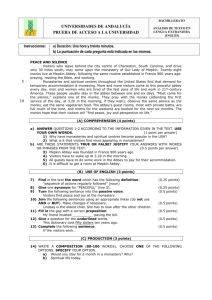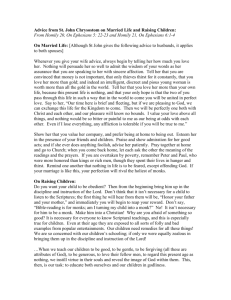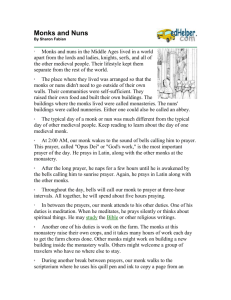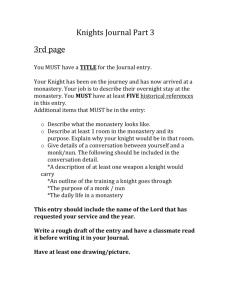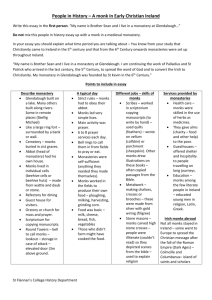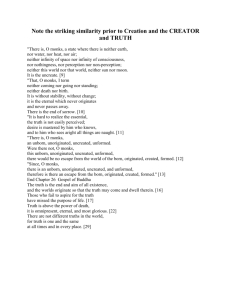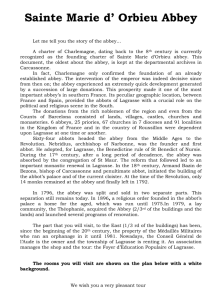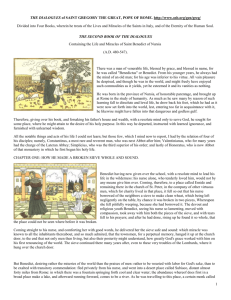Ctime473_Quarr_Abbey
advertisement
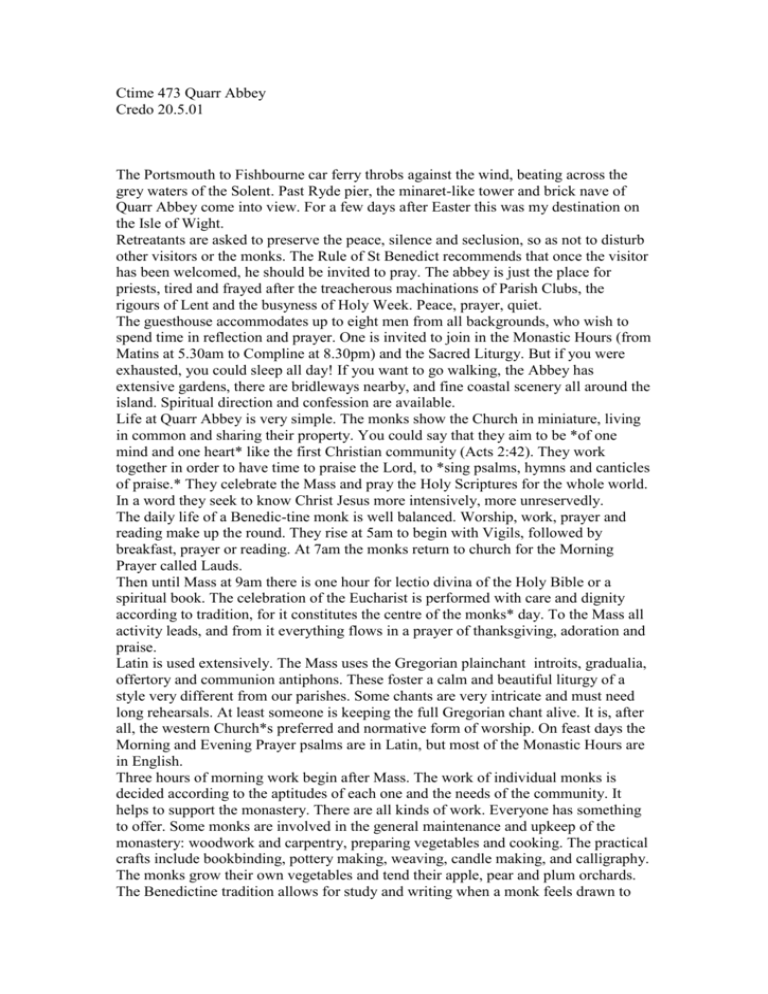
Ctime 473 Quarr Abbey Credo 20.5.01 The Portsmouth to Fishbourne car ferry throbs against the wind, beating across the grey waters of the Solent. Past Ryde pier, the minaret-like tower and brick nave of Quarr Abbey come into view. For a few days after Easter this was my destination on the Isle of Wight. Retreatants are asked to preserve the peace, silence and seclusion, so as not to disturb other visitors or the monks. The Rule of St Benedict recommends that once the visitor has been welcomed, he should be invited to pray. The abbey is just the place for priests, tired and frayed after the treacherous machinations of Parish Clubs, the rigours of Lent and the busyness of Holy Week. Peace, prayer, quiet. The guesthouse accommodates up to eight men from all backgrounds, who wish to spend time in reflection and prayer. One is invited to join in the Monastic Hours (from Matins at 5.30am to Compline at 8.30pm) and the Sacred Liturgy. But if you were exhausted, you could sleep all day! If you want to go walking, the Abbey has extensive gardens, there are bridleways nearby, and fine coastal scenery all around the island. Spiritual direction and confession are available. Life at Quarr Abbey is very simple. The monks show the Church in miniature, living in common and sharing their property. You could say that they aim to be *of one mind and one heart* like the first Christian community (Acts 2:42). They work together in order to have time to praise the Lord, to *sing psalms, hymns and canticles of praise.* They celebrate the Mass and pray the Holy Scriptures for the whole world. In a word they seek to know Christ Jesus more intensively, more unreservedly. The daily life of a Benedic-tine monk is well balanced. Worship, work, prayer and reading make up the round. They rise at 5am to begin with Vigils, followed by breakfast, prayer or reading. At 7am the monks return to church for the Morning Prayer called Lauds. Then until Mass at 9am there is one hour for lectio divina of the Holy Bible or a spiritual book. The celebration of the Eucharist is performed with care and dignity according to tradition, for it constitutes the centre of the monks* day. To the Mass all activity leads, and from it everything flows in a prayer of thanksgiving, adoration and praise. Latin is used extensively. The Mass uses the Gregorian plainchant introits, gradualia, offertory and communion antiphons. These foster a calm and beautiful liturgy of a style very different from our parishes. Some chants are very intricate and must need long rehearsals. At least someone is keeping the full Gregorian chant alive. It is, after all, the western Church*s preferred and normative form of worship. On feast days the Morning and Evening Prayer psalms are in Latin, but most of the Monastic Hours are in English. Three hours of morning work begin after Mass. The work of individual monks is decided according to the aptitudes of each one and the needs of the community. It helps to support the monastery. There are all kinds of work. Everyone has something to offer. Some monks are involved in the general maintenance and upkeep of the monastery: woodwork and carpentry, preparing vegetables and cooking. The practical crafts include bookbinding, pottery making, weaving, candle making, and calligraphy. The monks grow their own vegetables and tend their apple, pear and plum orchards. The Benedictine tradition allows for study and writing when a monk feels drawn to work of that kind. Nowadays, alternative life-styles are all the talk. The Benedictines offer an ecologically-friendly lifestyle of communal living, which has stood the test of time for 1600 years. For St Benedict, work honours the Creator*s gifts and the talents, which we have received from him. In his work the monk exercises and fulfils in part the potential inscribed in his nature. Enduring the hardship of work in union with Christ, the monk collaborates in a certain fashion with Jesus Christ in his redemptive work. The great disciplinary force for human nature is work; idleness is its ruin. Idleness is the enemy of the soul. At 1pm the short Office of Sext (the Sixth Hour) is celebrated, followed by lunch and recreation. We ate a satisfying lunch (and supper) with the monks in the refectory, to a Latin grace and a Scripture reading. Then continuous excerpts were read aloud from Elizabeth Longford*s Victoria R I. Osborne is only four miles away, so the book was of local interest. Perhaps our seminaries should reintroduce mealtime readings. At 2.20 there follows None (the Ninth Hour) and afternoon work. The community meets together for tea and a short recreation period before Vespers at 5 pm. After Vespers there is time for prayer, reading, study. Supper is at 7.30 and the day ends with Compline at 8.30, and the tolling of the bell for the Magnum Silentium, the great Silence during the night-hours. All the offices are chanted to tones which are simple but have a subtle beauty. St Benedict devotes a whole chapter of the Rule to Silence. In the monastic tradition silence is for the greater good. It is necessary for listening to the Word of God, so as to obey it and put it into practice, hence being * not hearers of the word only but doers of the word.* The ability to keep silence is a mark of a mature person. In an evernoisier world, oases of silence and prayer become even more important. In 1132 Baldwin de Redvers, fourth Lord of the Isle of Wight founded the ancient abbey. He brought a small community of monks from Savigny, but in 1147 his foundation affiliated with the Cistercians. The original title of the monastery was the Abbey of our Lady of the Quarry, referring to the stone quarry in the neighbouring village of Binstead. Quarr stone was used in the Tower of London and has recently helped to prove the date of the White Tower. The founder*s remains and those of his wife and princess Cicely, daughter of King Edward IV, still lie somewhere amidst the ruins. In 1536 Henry VIII suppressed the abbey. The building were demolished and the stone dragged away to build castles at Cowes and Yarmouth. A few low walls remain in a nearby field plus a cellarium tacked on to the back of a farmhouse. One of the old abbey bells is now in Binstead parish church and still summons people to worship. In 1907 monks returned to Quarr * the Benedictines of Solesmes in exile from France. One, Dom Paul Bellot, was an architect. He had lived in Spain, and drew up the plans for the new abbey in an unusual Mozarabic * Mujedar style, seen in cities like Toledo and Teruel. Dom Bellot is considered one of the pioneers of 20th century architectural Express-ionism. He used a beautiful light pink but very hard brick brought from Belgium. He employed 300 builders from the Isle of Wight, accustomed to building only dwelling-houses. The building of the refectory (dining room) and three sides of the cloister began immediately and was completed within less than a year. By 1912, under the direction of the monk-architect, the abbey church was completed. Its long Gothic nave and fine workmanship are very impressive. High above the sanctuary the brick vaulting ribs produce amazing 3-D intersections. Its brickwork is reminiscent of Spain and of some Polish monasteries. Although the original Solesmes community later returned to Normandy, some remained permanently in England. Today the monks still belong to the Solesmes congregation. The community numbers about 30 and includes eight novices. The average age seems to be in the thirties. It is international, with monks from Holland, Hungary, Nigeria, Ireland and elsewhere. The Lord Abbot is elected for life. The present Abbot Cuthbert Johnson is a renowned liturgist and a keen organist. The Benedictines are not a centralised organisation. Each monastery is independent and may vary in its stress on prayer and its type of work without changing the basic orientation. The Benedictine habit is black, composed of tunic, belt, scapular, and hood, plus the large flowing garment called the cowl for public worship. Hence the medieval appellation * the Black Monks. For 1500 years monks have lived their daily life by the Rule of St Benedict. It is a means of practising the Gospel and living Christian life as fully as possible. Benedict intended the Rule as a simple but safe guide for beginners, and the monastery is a *school of the Lord*s service*. It is a blessing for us all.

